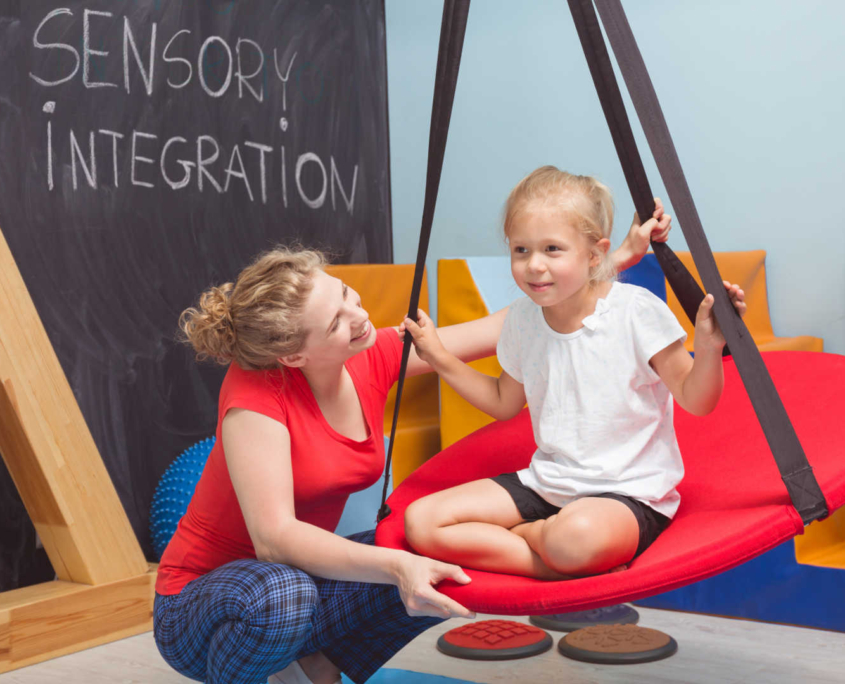Autism and periods

For many young teens, getting their period can be a challenging time as they navigate the physical and emotional changes that come with it. But for those on the autism spectrum, these challenges can be even more pronounced. Sensory sensitivities, difficulties with emotional regulation, and communication issues can all make dealing with periods particularly tough.
One of the biggest challenges for individuals with autism during their period is sensory sensitivities. Many people with autism already struggle with sensory processing issues, such as being overly sensitive to sounds, lights, textures, and smells. When it comes to menstruation, these sensitivities can be heightened and make the experience even more overwhelming.
We will be discussing
- What are periods?
- When do periods start?
- Challenges associated with periods and autism
- How to support your autistic daughter with her periods
- Consult your daughter’s pediatrician
Parents often focus on their children’s current state, but it’s important to remember that they will grow into adults. LeafWing can be a valuable resource for parents navigating their autistic children through the transition into adulthood.

What are periods?
Periods are a natural process that occurs in females as part of their reproductive cycle. For most females, this happens every 28 days or so, but it’s common for periods to be more or less frequent than this, ranging from every 23 days to every 35 days.
Your period can last between 2 and 7 days, but it usually lasts about 5 days. The bleeding tends to be heaviest in the first 2 days.
When your period is at its heaviest, the blood will be red. On lighter days, it may be pink or brown.
Parents need to communicate with their young autistic daughter that this is normal and does not mean you are injured or hurt.
It is important for parents to discuss the entire menstrual cycle with their daughters, not just focusing on the bleeding part. For example, you can start by explaining that her body will start to go through puberty. During puberty, a young woman begins to ovulate, releasing a mature egg from one of her ovaries. The ovaries are located in the pelvis and are the female reproductive organs. If the egg is fertilized by a sperm in the fallopian tube, pregnancy occurs. The fertilized egg attaches to the uterus lining, where the placenta forms. The placenta provides nutrition and oxygen to the fetus from the mother. If the egg is not fertilized, the lining of the uterus is shed during menstruation. This will help ensure that they better understand why this occurs every month.
When do periods start?
Periods usually begin at around the age of 12, although some girls will start them earlier or later.
A delay in starting periods isn’t usually a cause for concern. Most girls will begin having regular periods by ages 16 to 18.
PMS (premenstrual syndrome)
Changes in your body’s hormone levels before your period can cause physical and emotional changes.
This is known as PMS (premenstrual syndrome) or PMT (premenstrual tension).
There are many possible symptoms of PMS, but typical symptoms include:
- feeling bloated
- breast tenderness
- mood swings
- feeling irritable
- spotty skin
- low sex drive (loss of libido)
These symptoms usually improve when your period starts and disappear a few days afterward. Not all women who have periods experience PMS.
Managing your periods when you have autism
- Educate your daughter early so there are no surprises about the symptoms that her body will be experiencing and reduce the anxieties. Talk to her about the menstrual cycle, why she has a menstrual cycle, and the changes her body will be going through.
- Have a plan in place. Start talking about all the sanitary products and how to use them.
The main types of sanitary products are:- Sanitary pads – strips of padding with a sticky side you attach to your underwear to hold them in place. One side of the pad is made of an absorbent material that soaks up the blood.
- Tampons – a plug of soft material inserted into the vagina to absorb menstrual blood. A brand new product called TINA (Tampon INsertion Aid) helps individuals with disabilities to insert the tampon into the vagina.
- Period panties/underwear – they are worn like underwear, but have extra padding to absorb the flow and protect from leaks, while keeping you feeling fresh.

Challenges associated with periods and autism
Parents need to understand that adolescence can be challenging for young females, especially those with autism. Effective communication, task analysis, support, and patience are essential for helping them navigate this new stage in their lives. Parents can decide to use forward chaining or backward chaining techniques when trying to prepare their daughters to care for themselves during their periods.
One key aspect for parents to keep in mind is the heightened stress their daughter may experience during this time. The physical changes, emotional fluctuations, and sensory sensitivities that often accompany menstruation can be overwhelming for individuals with autism. Parents should be prepared to provide extra support and understanding during this period.
Parents need to recognize that their daughter may struggle to communicate her feelings and needs during her period. It is essential to create a safe and open environment where she feels comfortable expressing any discomfort or concerns she may have. Parents can use visual aids, social stories, or other forms of communication to help facilitate communication during this time. Additionally, providing her with the necessary support and resources to manage her period effectively can make a significant difference in her overall well-being.
Feelings your daughter with autism may be feeling:
- confusion due to the lack of clear, detailed information about periods and the common terms being used.
- feeling worried about disruption to routine, like:
- changes in showering and toileting routines
- having to wear period products
- having to use public toilets
- understanding why periods might change monthly due to age, stress, or childbirth
- understanding and being able to communicate the symptoms of premenstrual syndrome (PMS)
- change in mood swings and elevated meltdowns
Executive function deficiency, including:
- remembering to carry period products
- knowing the sequence of changing a sanitary pad or tampon
- knowing when to change a sanitary pad or tampon
How to support your autistic daughter with her periods
Autistic females may require additional support in understanding and preparing for menstruation. Providing clear descriptions and explanations in advance can help in alleviating confusion and stress.
Different individuals may require information in a format that is tailored to their needs, such as visual aids, social stories, books, pictures, and videos. It is important to use clear and straightforward language when discussing menstruation, as euphemisms and slang terms can cause confusion and anxiety.
Consult your daughter’s pediatrician
It is important to consider potential underlying factors when observing significant changes in your child’s behavior, such as pain, discomfort, fear, confusion, sadness, or sensory overload. Watch for signs like self-injury, changes in appetite or sleep, frequent complaints of feeling unwell, or a sudden disinterest in previously enjoyed activities.
Certain behaviors may indicate a medical problem or a significant mood issue. During adolescence, there is a higher prevalence of depression and anxiety in individuals with ASD, especially in those who are older and possess greater verbal and cognitive abilities.
Puberty brings hormonal changes for young teens, along with a more complex social environment. This can lead to feelings of being different from peers and increased levels of withdrawal, depression, and anxiety. Many teens struggle to express their emotions during this time, which can result in challenging behaviors.
If you notice any of these signs in your autistic daughter, it is important to consult with her pediatrician. They can help determine if a medical issue may contribute to the behavior changes or if emotional issues are at play.
LeafWing can be a valuable resource for developing individuals with autism for their transition into adulthood, as it is important to consider their future beyond the current state of childhood.
Related Glossary Terms
Other Related Articles
- Using Social Stories To Help Individuals With Autism In Classrooms And Other Settings
- How To Use Visuals To Help Students With Autism
Frequently asked questions about ABA therapy
What is ABA Therapy used for?
ABA-based therapy can be used in a multitude of areas. Currently, these interventions are used primarily with individuals living with ASD; however, their applications can be used with individuals living with pervasive developmental disorders as well as other disorders. For ASD, it can be used in effectively teaching specific skills that may not be in a child’s repertoire of skills to help him/her function better in their environment whether that be at home, school, or out in the community. In conjunction with skill acquisition programs, ABA-based interventions can also be used in addressing behavioral excesses (e.g., tantrum behaviors, aggressive behaviors, self-injurious behaviors). Lastly, it can also be utilized in parent/caregiver training.
In skill acquisition programs, a child’s repertoire of skills is assessed in the beginning phase of the services in key adaptive areas such as communication/language, self-help, social skills, and motor skills as well. Once skills to be taught are identified, a goal for each skill is developed and then addressed/taught by using ABA-based techniques to teach those important skills. Ultimately, an ABA-based therapy will facilitate a degree of maintenance (i.e., the child can still perform the learned behaviors in the absence of training/intervention over time) and generalization (i.e., the learned behaviors are observed to occur in situations different from the instructional setting). These two concepts are very important in any ABA-based intervention.
In behavior management, the challenging behaviors are assessed for their function in the beginning phase of the services. In this phase, the “why does this behavior happen in the first place?” is determined. Once known, an ABA-based therapy will be developed to not just decrease the occurrence of the behavior being addressed, but also teach the child a functionally-equivalent behavior that is socially-appropriate. For example, if a child resorts to tantrum behaviors when she is told she cannot have a specific item, she may be taught to accept an alternative or find an alternative for herself. Of course, we can only do this up to a certain point—the offering of alternatives. There comes a point when a ‘no’ means ‘no’ so the tantrum behavior will be left to run its course (i.e., to continue until it ceases). This is never easy and will take some time for parents/caregivers to get used to, but research has shown that over time and consistent application of an ABA-based behavior management program, the challenging behavior will get better.
In parent training, individuals that provide care for a child may receive customized “curriculum” that best fit their situation. A typical area covered in parent training is teaching responsible adults pertinent ABA-based concepts to help adults understand the rationale behind interventions that are being used in their child’s ABA-based services. Another area covered in parent training is teaching adults specific skill acquisition programs and/or behavior management programs that they will implement during family time. Other areas covered in parent training may be data collection, how to facilitate maintenance, how to facilitate generalization of learned skills to name a few.
There is no “one format” that will fit all children and their families’ needs. The ABA professionals you’re currently working with, with your participation, will develop an ABA-based treatment package that will best fit your child’s and your family’s needs. For more information regarding this topic, we encourage you to speak with your BCBA or reach out to us at [email protected].
Who Can Benefit From ABA Therapy?
There is a common misconception that the principles of ABA are specific to Autism. This is not the case. The principles and methods of ABA are scientifically backed and can be applied to any individual. With that said, the U.S. Surgeon General and the American Psychological Association consider ABA to be an evidence based practice. Forty years of extensive literature have documented ABA therapy as an effective and successful practice to reduce problem behavior and increase skills for individuals with intellectual disabilities and Autism Spectrum Disorders (ASD). Children, teenagers, and adults with ASD can benefit from ABA therapy. Especially when started early, ABA therapy can benefit individuals by targeting challenging behaviors, attention skills, play skills, communication, motor, social, and other skills. Individuals with other developmental challenges such as ADHD or intellectual disability can benefit from ABA therapy as well. While early intervention has been demonstrated to lead to more significant treatment outcomes, there is no specific age at which ABA therapy ceases to be helpful.
Additionally, parents and caregivers of individuals living with ASD can also benefit from the principles of ABA. Depending on the needs of your loved one, the use of specified ABA techniques in addition to 1:1 services, may help produce more desirable treatment outcomes. The term “caregiver training” is common in ABA services and refers to the individualized instruction that a BCBA or ABA Supervisor provides to parents and caregivers. This typically involves a combination of individualized ABA techniques and methods parents and caregivers can use outside of 1:1 sessions to facilitate ongoing progress in specified areas.
ABA therapy can help people living with ASD, intellectual disability, and other developmental challenges achieve their goals and live higher quality lives.
What does ABA Therapy look like?
Agencies that provide ABA-based services in the home-setting are more likely to implement ABA services similarly than doing the same exact protocols or procedures. Regardless, an ABA agency under the guidance of a Board-Certified Behavior Analyst follows the same research-based theories to guide treatment that all other acceptable ABA agencies use.
ABA-based services start with a functional behavior assessment (FBA). In a nutshell, a FBA assesses why the behaviors may be happening in the first place. From there, the FBA will also determine the best way to address the difficulties using tactics that have been proven effective over time with a focus on behavioral replacement versus simple elimination of a problem behavior. The FBA will also have recommendations for other relevant skills/behaviors to be taught and parent skills that can be taught in a parent training format to name a few. From there, the intensity of the ABA-based services is determined, again, based on the clinical needs of your child. The completed FBA is then submitted to the funding source for approval.
One-on-one sessions between a behavior technician and your child will start once services are approved. The duration per session and the frequency of these sessions per week/month will all depend on how many hours your child’s ABA services have been approved for—usually, this will be the number recommended in the FBA. The sessions are used to teach identified skills/behaviors via effective teaching procedures. Another aspect of ABA-based services in the home-setting is parent training. Parent training can take many forms depending on what goals have been established during the FBA process. The number of hours dedicated for parent training is also variable and solely depends on the clinical need for it. If a 1:1 session is between a behavior technician and your child, a parent training session or appointment is between you and the case supervisor and with and without your child present, depending on the parent goal(s) identified. Parent training service’s goal is for you to be able to have ample skills/knowledge in order for you to become more effective in addressing behavioral difficulties as they occur outside of scheduled ABA sessions. Depending on the goals established, you may be required to participate in your child’s 1:1 sessions. These participations are a good way for you to practice what you have learned from the case supervisor while at the same time, having the behavior technician available to you to give you feedback as you practice on those new skills.
As mentioned in the beginning, no two ABA agencies will do the same exact thing when it comes to providing ABA services; however, good agencies will always base their practice on the same empirically-proven procedures.
How do I start ABA Therapy?
In most cases, the first item required to start ABA therapy is the individual’s autism spectrum disorder (ASD) diagnosis report. This is typically conducted by a doctor such as a psychiatrist, psychologist, or a developmental pediatrician. Most ABA therapy agencies and insurance companies will ask for a copy of this diagnosis report during the intake process as it is required to request an ABA assessment authorization from the individual’s medical insurance provider.
The second item required to start ABA therapy is a funding source. In the United States, and in cases where Medi-Cal or Medicare insurances are involved, there is a legal requirement for ABA services to be covered when there is a medical necessity (ASD diagnosis). Medi-Cal and Medicare cover all medically necessary behavioral health treatment services for beneficiaries. This typically includes children diagnosed with ASD. Since Applied Behavior Analysis is an evidence based and effective treatment for individuals with ASD, it is considered a covered treatment when medically necessary. In many cases, private insurance will also cover ABA services when medically necessary, however in these cases, it is best to speak directly with your medical insurance provider to determine the specifics of the coverage and to ensure that ABA is in fact, a covered benefit. Additionally, some families opt to pay for ABA services out-of-pocket.
The next step to starting ABA therapy is to contact an ABA provider whom you are interested in working with. Depending on your geographic location, ABA agencies exist in many cities across the United States. Your insurance carrier, local support groups, and even a thorough online search can help you find reputable and properly credentialed ABA agencies near you. Our organization, LeafWing Center, is based in southern California and is recognized for aiding people with ASD achieve their goals with the research based on applied behavior analysis.
Once you have identified the ABA provider with whom you wish to work, they should help you facilitate the next steps. These will include facilitating paperwork and authorizations with your funding source. Once the assessment process begins, a BCBA (Board Certified Behavior Analyst) or qualified Program Supervisor should get in contact with you to arrange times in which interviews with parents/caregivers and observations of your loved one can be conducted. This will help in the process of gathering important clinical information so that with your collaboration, the most effective treatment plans and goals can be established for your loved one. This process is referred to as the Functional Behavior Assessment (FBA) and is elaborated on in different blog posts on our website. With regard as to what can be expected once ABA therapy begins, please read our blog post titled: When You Start an ABA program, What Should You Reasonably Expect from Your Service Provider?



























